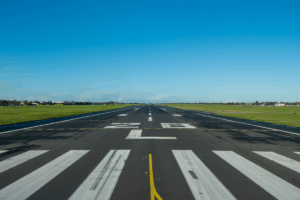When one thinks of airport lighting systems, images of high-traffic runways and complex lighting systems providing navigational aid to pilots of large aircraft during landing and taxiing along the busy tarmac often come to mind.
It’s a given that large airports such as JFK, O’Hare, and Heathrow would have high-tech runway infrastructures. However, the importance of similar systems enhancing the safety and efficiency of the thousands of small and regional airports that comprise the backbone of national and local aviation networks can’t be ignored.
The challenge for many of these airports is that they are operated by minimal staff, often have an aging infrastructure, and sometimes have budget constraints that make investing in advanced runway lighting an unaffordable luxury.
However, the truth is that adopting modern technology to help manage aircraft movement shouldn’t be considered a cost but rather an investment. Not only do advanced lighting runway systems enhance airport safety and operational efficiency, but they also unlock huge opportunities that support a smaller airport’s growth strategy.
Ensuring Public Safety In An Emergency
Pilots rely heavily on runway edge lights, threshold lights, approach lighting systems, and rotating beacons to navigate their aircraft safely to the airfield, especially at night or in inclement weather. They also help pilots successfully move along the tarmac to avoid incursions.
However, many smaller airports lack systems adequate enough to make their airfields usable during non-daylight hours or if visibility is poor. Without the proper lighting infrastructure, pilots can misjudge distances, overshoot runways, or even fail to locate the runway entirely, especially at airports in remote areas that lack other navigational aids, such as well-lit buildings or highways.
This situation can have profound implications for scheduled flights and local emergency response operations during a medical crisis, disaster relief operations, or lifesaving missions when time is of the essence. All airports, regardless of size or location, must be well-equipped to support the immediate needs of their local areas and mitigate the effects of an unexpected catastrophe.
Read More: The Critical Role Of Airport Lighting In Aviation Safety
How Airport Lighting Supports Growth For Smaller Airports
Of course, safety and efficiency are the main reasons airports use runway lighting systems. However, smaller airports can leverage the technology to meet these aims and unlock growth potential that can lead to bigger profits over time.
For example, a robust runway lighting system supports night flights, which will increase the airport’s traffic capacity. Allowing safe night flights will complement regularly scheduled flights and open the airport up to other air traffic that requires immediate access or flexible scheduling, such as medical or emergency flights, charter flights, business travel, and even flight training schools.
Allowing 24-hour operations also enhances cargo handling capability, which can attract air traffic from freight companies.
Furthermore, expanding a smaller airport’s operating hours can attract more investors, transforming the operation into a hub of not just air traffic but also valuable opportunities to increase revenues.
Bringing Equity To Underserved Communities
In major urban centres, much of the local population considers their local international airport another transportation hub. Travellers enjoy state-of-the-art runway lighting systems and other conveniences not found in more isolated locations served by smaller airports.
However, regional airports in rural, remote, or otherwise underserved areas are more than a gateway to their next flight. They’re a vital link to the rest of the world. In some cases, they’re an actual lifeline through which necessary supplies and economic support that sustain communities arrive. They also provide the primary mode of transportation for people seeking urgent medical care from urban healthcare facilities.
However, as critical as these regional airports are to their communities, many have outdated, substandard runway lighting systems that limit their capacity to serve their local populations.
Investing in modern runway light infrastructure shows that these communities and their needs matter and affirms that rural airport safety is taken as seriously as that in major urban centers.
Build Profits With Cost-Effective Runway Lighting Solutions
Smaller airports with limited budgets can access customized, cost-effective solutions that enhance their operations’ safety and efficiency and actually help grow their bottom line.
For example, LED airfield lighting systems consume significantly less power, have longer lifespans, and require far less maintenance than traditional halogen or incandescent systems. In fact, small airports can recoup their investment in LED technology within a few years through reduced energy costs and fewer repairs.
The expert team at Airport Lighting Company can help you custom-design a high-quality runway lighting and power system that will meet your budget and put you closer to your future growth plans. Give us a call anytime – we’re always happy to provide professional advice and connect you with high-tech solutions that will improve your operational efficiency.
Read More: About Airport Lighting Company
Call Airport Lighting Company For The Latest In Airport Lighting Technology
The Airport Lighting Company team is standing by to answer your questions about how our tech-based products can help improve the safety, reliability, and efficiency of your runways. Call 315-682-6460 for fast, friendly service you can count on.


